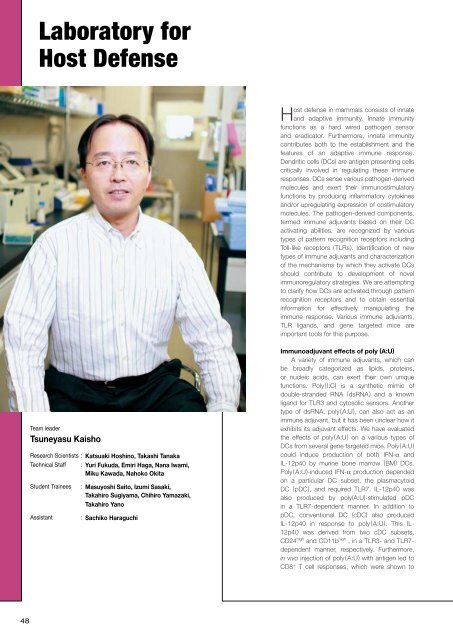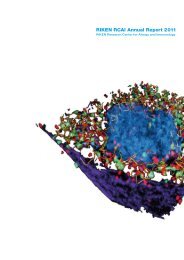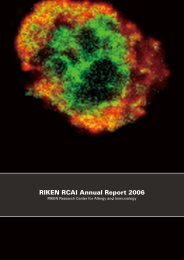in vivo
in vivo
in vivo
Create successful ePaper yourself
Turn your PDF publications into a flip-book with our unique Google optimized e-Paper software.
Laboratory for<br />
Host Defense<br />
Host defense <strong>in</strong> mammals consists of <strong>in</strong>nate<br />
and adaptive immunity. Innate immunity<br />
functions as a hard wired pathogen sensor<br />
and eradicator. Furthermore, <strong>in</strong>nate immunity<br />
contributes both to the establishment and the<br />
features of an adaptive immune response.<br />
Dendritic cells (DCs) are antigen present<strong>in</strong>g cells<br />
critically <strong>in</strong>volved <strong>in</strong> regulat<strong>in</strong>g these immune<br />
responses. DCs sense various pathogen-derived<br />
molecules and exert their immunostimulatory<br />
functions by produc<strong>in</strong>g <strong>in</strong>flammatory cytok<strong>in</strong>es<br />
and/or upregulat<strong>in</strong>g expression of costimulatory<br />
molecules. The pathogen-derived components,<br />
termed immune adjuvants based on their DC<br />
activat<strong>in</strong>g abilities, are recognized by various<br />
types of pattern recognition receptors <strong>in</strong>clud<strong>in</strong>g<br />
Toll-like receptors (TLRs). Identification of new<br />
types of immune adjuvants and characterization<br />
of the mechanisms by which they activate DCs<br />
should contribute to development of novel<br />
immunoregulatory strategies. We are attempt<strong>in</strong>g<br />
to clarify how DCs are activated through pattern<br />
recognition receptors and to obta<strong>in</strong> essential<br />
<strong>in</strong>formation for effectively manipulat<strong>in</strong>g the<br />
immune response. Various immune adjuvants,<br />
TLR ligands, and gene targeted mice are<br />
important tools for this purpose.<br />
Team leader<br />
Tsuneyasu Kaisho<br />
Research Scientists : Katsuaki Hosh<strong>in</strong>o, Takashi Tanaka<br />
Technical Staff : Yuri Fukuda, Emiri Haga, Nana Iwami,<br />
Miku Kawada, Nahoko Okita<br />
Student Tra<strong>in</strong>ees<br />
Assistant<br />
: Masuyoshi Saito, Izumi Sasaki,<br />
Takahiro Sugiyama, Chihiro Yamazaki,<br />
Takahiro Yano<br />
: Sachiko Haraguchi<br />
Immunoadjuvant effects of poly (A:U)<br />
A variety of immune adjuvants, which can<br />
be broadly categorized as lipids, prote<strong>in</strong>s,<br />
or nucleic acids, can exert their own unique<br />
functions. Poly(I:C) is a synthetic mimic of<br />
double-stranded RNA (dsRNA) and a known<br />
ligand for TLR3 and cytosolic sensors. Another<br />
type of dsRNA, poly(A:U), can also act as an<br />
immune adjuvant, but it has been unclear how it<br />
exhibits its adjuvant effects. We have evaluated<br />
the effects of poly(A:U) on a various types of<br />
DCs from several gene targeted mice. Poly(A:U)<br />
could <strong>in</strong>duce production of both IFN-α and<br />
IL-12p40 by mur<strong>in</strong>e bone marrow (BM) DCs.<br />
Poly(A:U)-<strong>in</strong>duced IFN-α production depended<br />
on a particular DC subset, the plasmacytoid<br />
DC (pDC), and required TLR7. IL-12p40 was<br />
also produced by poly(A:U)-stimulated pDC<br />
<strong>in</strong> a TLR7-dependent manner. In addition to<br />
pDC, conventional DC (cDC) also produced<br />
IL-12p40 <strong>in</strong> response to poly(A:U). This IL-<br />
12p40 was derived from two cDC subsets,<br />
CD24 high and CD11b high , <strong>in</strong> a TLR3- and TLR7-<br />
dependent manner, respectively. Furthermore,<br />
<strong>in</strong> <strong>vivo</strong> <strong>in</strong>jection of poly(A:U) with antigen led to<br />
CD8 + T cell responses, which were shown to<br />
48





